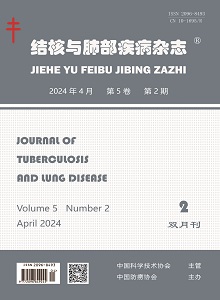-
Study on adverse reactions of 1200 children on tuberculosis preventive treatment
- WEI Xiao-hui, JIN Xiao-wei, DUAN Hai-xia, JIN Hong-jian
-
Journal of Tuberculosis and Lung Health. 2015, 4(4):
233-238.
doi:10.3969/j.issn.2095-3755.2015.04.006
-
 Abstract
(
389 )
Abstract
(
389 )
 PDF (768KB)
(
374
)
PDF (768KB)
(
374
)
 Save
Save
-
References |
Related Articles |
Metrics
Objective To study the adverse reactions of 1200 children aged between 6-15 years old on rifapentine (L) and isoniazid (H) for TB preventive treatment.Methods A total of 1200 cases of children aged 6-15 at Xinmi from 2012—2014, whose tuberculin test were strongly positive, were selected. To observe the adverse reaction through the blood and liver function tests before and 1, 2 and 3 months after the treatment onset.Results (1) The adverse reaction incidence rate was 7.0% (84/120) in the first month, for boys and girls respectively 7.2% (44/614) and 6.8% (40/586), no significant difference (χ2=0.05, P>0.05). Among them 1.2% (14/1200) of gastrointestinal reactions, 2.8% (33/1200) of hepatic dysfunction, 3.1% (37/1200) of decreased white blood cell. (2) The adverse reaction incidence rate was 7.1% (34/482) in the second month, for boys and girls respectively 7.5% (19/254) and 6.6% (15/228), no significant difference (χ2=0.15, P>0.05). Among them 0.6% (3/482) of gastrointestinal reactions, 2.5% (12/482) of hepatic dysfunction, 3.9% (19/482) of decreased white blood cell. (3) The adverse reaction incidence rate was 6.2% (27/439) in the third month, for boys and girls respectively 7.2% (16/228) and 5.2% (11/211), no significant difference (χ2=0.62, P>0.05). Among them 1.4% (6/439) of hepatic dysfunction, 4.8% (21/439) of decreased white blood cell. (4) The average monthly incidence of adverse reactions was 6.8% (145/2121), 7.2% (79/1096) and 6.4% (66/1025) respectively for boys and girls, no significant difference (χ2=0.49, P>0.05). (5) Adverse reaction incidence in children aged 6-15 years old in turn was 11.6% (13/112), 9.1% (17/187), 7.2% (11/152), 5.4% (7/129), 6.7% (8/119), 3.3% (3/92), 7.1% (10/141), 7.1% (8/112), 5.7% (3/53) and 3.9% (4/103) respectively, there was no statistically significant difference in the incidence of adverse reactions by age (χ2=7.86, P>0.05).Conclusion The adverse reaction incidence rate of L+H regimen for preventive treatment for children aged between 6-15 years old are in normal level, but we need to perform periodic liver function and blood test during treatment so as to avoid severe reaction.

 Wechat
Wechat